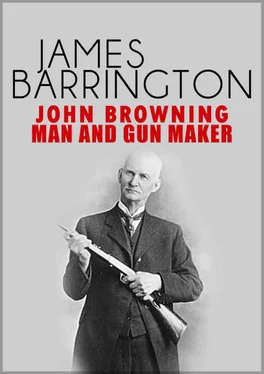As far as Browning was concerned, this was ludicrous. His parting shot to the Chief of Ordnance was to suggest that he should find the man in Washington who apparently understood the John Moses Browning designs better than John Moses Browning did, and then send him to Hartford, which would allow John to go home. He had no further problems with red tape.
A major problem faced by the allied forces in Europe was the armour plating on German vehicles, which the relatively small .30 calibre rounds fired by the Browning weapons would not penetrate. Browning was called in to assist after army engineers had tried, and failed, to modify his 1917 water-cooled machine-gun to take the French 11 mm round. Quite why he was not asked to assist from the start is not clear — presumably the American Army believed they could design weapons as well as fire them — but within a short time Browning had completed the modifications and was able to test-fire a .50 calibre weapon similar in basic design to his smaller gun.
This weapon was officially tested at the Aberdeen Proving Ground in Maryland on 15 November 1918, four days after the signing of the Armistice. The test was typically successful and, though too late to see service in the First World War, the gun was used to good effect in the Korean War and the Second World War. It was designated the M2, but became known almost immediately to most American soldiers as the ‘Ma Deuce’.
Both the .30 and .50 calibre weapons later spawned air-cooled variants intended for aircraft use, and both proved highly successful. The .50 aircraft gun was outstanding: firing an 800-grain bullet at 2700 feet per second, it could penetrate over an inch of armour plate at close range, and during the Tunisian campaign thirty five allied fighter aircraft armed with Brownings accounted for seventy two enemy aircraft for a total expenditure of under two hundred rounds per gun.
The Ma Deuce is being used in military operations around the world even today, and is still giving good service, despite being one of the oldest models of firearm in the American military arsenal. The evolution of tank armour meant that it soon lost its role as an anti-tank weapon, but became standard equipment on US military vehicles, ships, aircraft and for infantry formations. It’s still a very effective anti-aircraft, anti-vehicle and anti-personnel weapon. Reportedly, during the Second World War, Herman Göring stated that if the German Air Force had been equipped with the Browning .50-calibre machine-gun, the outcome of the Battle of Britain would have been very different. During the Korean War, quad-mounted M2s on half-track vehicles became life-savers for the heavily outnumbered American troops as they faced massive human wave attacks.
In one celebrated incident, at Holtzwihr in France in January 1945, Lieutenant Audie Murphy and his small force of troops were attacked by a superior infantry force and six German tanks. Murphy ordered his troops to withdraw while he tried to defend the position by calling in artillery strikes. As the enemy forces advanced towards him, he jumped onto a wrecked US tank destroyer vehicle and used the M2 mounted on it against the Germans. He killed scores of enemy soldiers, some within a few yards of his position, and eventually forced the German tanks to withdraw. Murphy was wounded, but survived the encounter, and was awarded the Medal of Honour for his bravery and courage.
The M2 has been both copied and imitated, but modern technology has yet to produce a convincing replacement weapon which is clearly capable of surpassing the total reliability and rugged performance of the Browning design, now well over a century old.
John Browning’s final military design was the 37 mm cannon, and was a development in which he was extremely reluctant to become involved. Ordnance engineers in America had commenced work on two weapons of this type before the end of the First World War, but neither was a resounding success. One failed to operate at all, while the other — the Baldwin cannon — was never able to fire in excess of eight rounds without malfunctioning.
When John Browning was asked to look at the cannon to attempt to rectify its defects, almost the first thing he asked was where the cheese should be put, for it resembled a large and poorly-designed mousetrap. It was obvious even then that a completely new concept was required, but John was still reluctant to undertake the work.
Ostensibly, his reason was that he was too busy with developing his various sporting arms, but the truth, as he explained in 1920 to the Chief of Ordnance, General C C Williams, was that he knew from past experience of government contracts that the design was only the beginning. As soon as the 37 mm cannon had been successfully fired, someone would want a higher velocity or a faster cyclic rate or a larger calibre weapon of the same type. And Browning could frankly have done without the aggravation; he was sixty-five years old and very tired, having worked virtually every single day of his life.
But he thought about the gun, even if had said he wasn’t going to, and in January 1921, probably against his own better judgement, he started work on it. Within three months it was finished, though the cartridges for it, ordered when he commenced work, had not yet arrived. Fortunately Browning managed to obtain a supply, albeit carrying TNT charges, from a government arsenal not far from Ogden.
The first test-firing outside Ogden was of a clip of five cartridges, which raced through the action in a little under two seconds, the TNT heads exploding against the mountain. With the action thus proved, the very basic mount was modified and John took the cannon to the Aberdeen Proving Ground for official demonstrations.
The contrast there between the unsuccessful, but beautifully made, Baldwin weapon and the battered Browning prototype was very marked. The former looked superb, with fine detailed workmanship, but broke every few rounds, while the Browning, with hammer and forging marks all over it, fired and kept on firing without a pause unless it was intentional.
As the echoes of the last shot died away, Browning’s prediction to the Chief of Ordnance was proved accurate. One of the first comments was an expression of regret that the velocity of the cartridge was only about 1400 feet per second, and could Mr Browning possibly adapt the weapon to a round with a muzzle velocity of about two thousand feet per second?
The answer was that he could and did, and then produced a third derivation which fired a round over a foot long with a velocity of over three thousand feet per second. But the war was long over by then and, though a few units were made in England in 1929, there seemed neither need nor inclination to produce such weapons, so the working models and the associated drawings were put into store. They were not to be seen again until 1935 when the expanding German nation again cast its shadow over Europe, and volume manufacture of the largest Browning-designed cannon commenced in earnest.
Browning’s work with Fabrique Nationale inevitably resulted in him creating a second home for himself and his family in Belgium, and on the streets of Liège he became a familiar and well-loved figure. Wearing his wide-brimmed hat and cape, his six-foot tall figure was quite unmistakable. So as not to have to rely on interpreters in his dealing with the craftsmen and workers at the FN factory, and to avoid any misunderstandings in translation, Browning taught himself French.
At the plant, he was nicknamed Le Maître or ‘The Master’, and in 1914, in recognition of his genius, and also because he had virtually single-handedly transformed Fabrique Nationale from a near-bankrupt bicycle factory to an enormously profitable world-class manufacturer of firearms, he was knighted on the orders of King Albert of Belgium, despite the fact that he was still an American citizen.
Читать дальше












